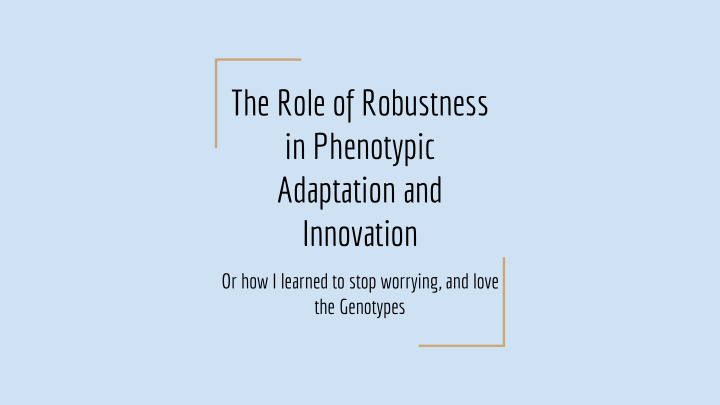



The Role of Robustness in Phenotypic Adaptation and Innovation Or how I learned to stop worrying, and love the Genotypes
Why do we care about Phenotypes? Set of observable characteristics regarding an organism ● Influenced by Genotype (genes), and environment ● Gene example: Eye color ○ Env. Example: Flamingo pinkness ○ Phenotypes are “perturbed” by genotypes and environment ● Robustness is important; mutations are bad ● Except when they’re not… ○ One of the main points of the paper ○
How do we get better? Organism populations want to have superior genotypes ● Whose expressed phenotypes are better suited for the environment ○ Superiority may be far away, and require “undoing” ● Like solving a Rubix cube ○ Solution: networks of different genotypes with the same phenotype ● Ex: Macromolecules with oxygen-binding globins ○
General Idea Mutations are mostly bad , but different genotypes producing the same ● phenotype is good Producing the same phenotype is better for the current environment ○ Environmental perturbations force different genotypes to respond in different ways ○ Networks of genotypes are better suited to environmental changes, while preserving the ○ same phenotype ensures success in the current environment
Minimally Robust vs. Moderately Robust Genotypes Line types connecting neighbors ● Dashed: A neighboring genotype with a ○ differing phenotype Solid: A neighboring genotype with the same ○ phenotype Which has more phenotypic variability? ○ B = 4 + 5 + 4 = 13 ○ New Accessible Phenotypes ● Shows accessible phenotypes for one, two, ○ and three mutations away. L is the number of nucleotides in the RNA ○ 3L is the number of accessible phenotypes ○ after one mutation. The guide RNA’s network is actually 9.1x10^17 ○ += 3.3x10^16
Cryptic Variation Two lines of experimental evidence ● First Experiment ○ Involves one synthetic (self-ligating) and one ■ natural ribozyme (self-cleaving). 40 mutational steps to create a hybrid. ■ However, biological evolution does not use such ○ premeditated paths. Second experiment ○ Cryptic variation: genotypic variation that is not ■ visible on the level of phenotype. Experiment done with the same RNA, two ■ different populations. Population with more cryptic variation evolved 6 ■ times faster.
Phenotypic variability affected by robustness Genotypes on a large genotype network are more robust to mutation ● than a small one. Two different phenomena effects on phenotypic variability ● Number of different phenotypes in the neighbourhood ○ The rate of a population spreads through a genotype network ○
RNA Robustness and Variation Two phenomena have opposite effects on variability ● High phenotypic robustness entails low variability in first phenomenon ○ High phenotypic robustness entails high variability in second phenomenon ○ RNA secondary phenomenon dominant influence on phenotypic ● variability High robustness is associated with superior evolutionary adaptation ● Robustness can increase the ability of RNA and protein molecules to ● adapt in evolution
Robustness can help avoid conflict Conflict between “population” and “individual” ● How does Robustness help avoid conflict ? ● RNA , poteins ○
Summary and Questions in the Field Two Roles of Robustness in Evolution ● Existence of genotype networks ○ Accelerating dynamics of change, increasing exploration ○ Remaining Questions in the Field ● How do the sizes of evolving populations and their mutation rates interact with ○ robustness to influence phenotypic variability? Does robustness evolve in a way that facilitates evolutionary adaptation and innovation? ○ Does natural selection favor robust phenotypes?
Recommend
More recommend